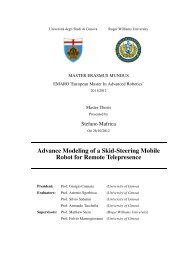Architecture Program Report Master of Architecture - Roger Williams ...
Architecture Program Report Master of Architecture - Roger Williams ...
Architecture Program Report Master of Architecture - Roger Williams ...
Create successful ePaper yourself
Turn your PDF publications into a flip-book with our unique Google optimized e-Paper software.
Course:<br />
ARCH 416 Advanced Topical Design Studio: Urban, 5 credits<br />
Boston: Inner Belt and Brickbottom, Somerville: Reinventing the Edge<br />
Course Description:<br />
This advanced design studio examines the role <strong>of</strong> <strong>Architecture</strong> as a critical component <strong>of</strong> the larger built<br />
environment and <strong>of</strong> the public realm. As such, the projects engaged within this studio focus on issues and<br />
concerns impacting local and/or global communities. This studio also explores the role <strong>of</strong> architecture in<br />
relation to allied disciplines such as Urban Design, Historic Preservation, Planning and Landscape<br />
<strong>Architecture</strong>, and in relation to the various formal and informal constituencies that influence the shape <strong>of</strong> the<br />
urban fabric.<br />
Course Goals & Objectives:<br />
The site on an incredible land resource with an unprecedented potential for access to existing and proposed<br />
transit infrastructure compared to any site outside <strong>of</strong> downtown Boston. The overarching opportunity here is to<br />
leverage these assets to set up conditions through an urban framework that will transform this area into a<br />
thriving, mixed-use, mass transit based, equitable, economically productive and sustainable urban<br />
neighborhood. Students will have the opportunity to meet with various constituents from the community, city<br />
and the State government and present their final project to them.<br />
To understand traditional and emerging urban and development patterns for American cities<br />
To understand issues associated with post-industrial lands and develop creative and<br />
transformative alternatives<br />
To understand the impact and role <strong>of</strong> large projects such as the stadium and transit line<br />
in revitalizing parts <strong>of</strong> cities<br />
To understand the architectural typologies <strong>of</strong> various program elements<br />
To evaluate the environmental impacts <strong>of</strong> urban development and find ways to minimize them<br />
To develop critical thinking and visual communication skills in order to engage the public by working<br />
with the constituents and local community on critical issues.<br />
Student Performance Criteria addressed (designated NAAB Coverage only):<br />
A. 10. Cultural Diversity<br />
C. 2. Human Behavior<br />
C. 6. Leadership<br />
C.9. Community and Social Responsibility<br />
Topical Outline:<br />
1. Research (team) 10%<br />
2. Site Analysis (team) 10%<br />
3. <strong>Master</strong>-planning (team/individual) 25%<br />
4. Architectural Scale (team/individual) 20%<br />
5. Final Comprehensive Presentation 25%<br />
6. Participation / Process 10%<br />
Prerequisites: ARCH 313 Architectural Design Core Studio V, Arch 321 Site + Environment, Arch 322<br />
Acoustics and Lighting, Arch 325 History <strong>of</strong> Modern <strong>Architecture</strong><br />
Textbooks/Learning Resources:<br />
Johnson, Stephen; A Natural History <strong>of</strong> Innovation; Meyer, Han; Delta Urbanism, The Netherlands;<br />
Greenberg, Ken; Walking Home; Surowiecki, James; The Wisdom <strong>of</strong> Crowds<br />
Hillier, Bill; Social Logic <strong>of</strong> Space; Wheaton, <strong>Williams</strong>; Urban Economics and Real Estate Markets; Varanasi,<br />
Kishore, Private Urbanism<br />
Offered: Fall 2011<br />
Faculty:<br />
Kishore Varanasi, Adjunct Faculty

















